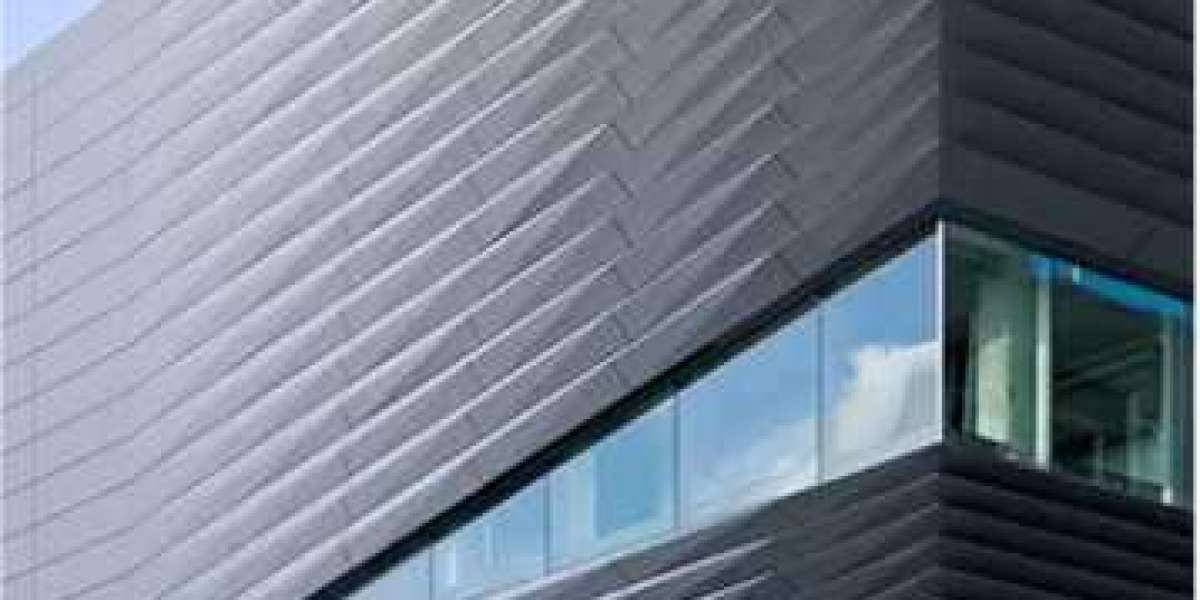Introduction to TI-ZN Composite Panels
In the ever-evolving world of architecture, innovative solutions are constantly sought after to create structures that not only stand out but also enhance sustainability and energy efficiency. Enter TI-ZN composite panels – a game-changer in the realm of modern construction materials! With their remarkable durability, low maintenance requirements, and eco-friendly features, these panels have swiftly become the go-to choice for architects and designers.
But what exactly sets TI-ZN composite panels apart from traditional building materials? In this blog post, we will delve into their numerous benefits that make them an indispensable asset in contemporary architectural marvels. From exceptional resilience to cost-effectiveness and beyond, let's explore how these revolutionary panels are shaping the future of modern design. So fasten your seatbelts as we embark on a journey through the incredible advantages offered by TI-ZN composite panels!
The Advantages of Using TI-ZN Composite Panels in Architecture
TI-ZN composite panels have revolutionized the field of architecture, offering a wide range of benefits that make them an ideal choice for modern building projects. One major advantage is their exceptional durability and low maintenance requirements. These panels are made with a combination of titanium and zinc, which makes them resistant to corrosion, weathering, and impact damage. This means that buildings clad in TI-ZN composite panels can withstand harsh environmental conditions and remain looking pristine for years to come.
In addition to their durability, TI-ZN composite panels also offer significant energy efficiency advantages. Their high thermal insulation properties help reduce heat transfer between the interior and exterior of the building, resulting in lower energy consumption for heating or cooling purposes. This not only leads to cost savings but also contributes towards sustainable construction practices by reducing carbon emissions.
Another key advantage of using TI-ZN composite panels is their cost-effectiveness in the long run. While they may require a slightly higher upfront investment compared to other cladding materials, such as aluminum or steel, their superior durability translates into lower maintenance costs over time. Additionally, their energy-saving properties can result in substantial long-term savings on utility bills.
With these numerous advantages offered by TI-ZN composite panels – including durability, low maintenance requirements, energy efficiency, sustainability benefits – it's clear why they are becoming increasingly popular in modern architecture projects around the world. Architects and designers can confidently choose these innovative cladding materials knowing that they will enhance both the aesthetic appeal and functionality of their structures while ensuring longevity and sustainability for years to come!
Durability and Maintenance Benefits
One of the key advantages of TI-ZN composite panels in modern architecture is their exceptional durability. These panels are designed to withstand harsh weather conditions, offering long-lasting protection for buildings. With their superior resistance to corrosion, fading, and cracking, TI-ZN composite panels can maintain their aesthetic appeal for years to come.
In addition to being durable, these panels also require minimal maintenance. Unlike traditional building materials such as wood or concrete that may need regular painting or sealing, TI-ZN composite panels are virtually maintenance-free. This not only saves time and effort but also reduces overall maintenance costs.
Furthermore, the inherent strength of TI-ZN composite panels makes them highly resistant to impact damage. This means that they can withstand accidental impacts from hailstorms or other objects without sustaining significant harm. As a result, buildings clad with TI-ZN composite panels remain intact and preserve their structural integrity over time.
The low-maintenance nature of these panels also contributes to their sustainability aspect. By minimizing the need for ongoing repairs and replacements, they reduce waste generation and environmental impact associated with conventional construction practices.
The durability and low-maintenance benefits offered by TI-ZN composite panels make them an ideal choice for architects seeking long-term solutions that combine aesthetics with practicality.
Energy Efficiency and Sustainability
Energy Efficiency and Sustainability are two key factors that architects consider when designing modern buildings. With the increasing focus on reducing carbon emissions and conserving energy, TI-ZN Composite Panels have emerged as a popular choice in sustainable architecture.
One of the major benefits of TI-ZN Composite Panels is their excellent insulation properties. These panels help to regulate temperature inside the building, minimizing heat loss during winter and preventing heat gain in summer. As a result, buildings equipped with these panels require less energy for heating or cooling, leading to reduced energy consumption and lower utility bills.
Moreover, TI-ZN Composite Panels are made from recyclable materials such as aluminum and zinc. This makes them an environmentally friendly option for designers who prioritize sustainability. By using these panels, architects can contribute towards reducing waste generation while still achieving aesthetically pleasing designs.
In addition to their insulation qualities and eco-friendliness, TI-ZN Composite Panels also offer longevity. Their durability ensures that they maintain their performance over time without requiring frequent maintenance or replacement. This further enhances their sustainability credentials since fewer resources are consumed in maintaining them.
Furthermore, the lightweight nature of these composite panels reduces transportation costs during installation due to their ease of handling. This not only saves money but also minimizes fuel consumption during transportation.
Energy Efficiency and Sustainability remain at the forefront of architectural considerations today, making TI-ZN Composite Panels an ideal choice for modern projects seeking long-term cost savings while minimizing environmental impact through efficient resource utilization.
Cost-effectiveness in the Long Run
When it comes to architectural projects, cost-effectiveness is a crucial consideration for both designers and clients. Long-term expenses can add up quickly, making it essential to choose materials that offer durability without breaking the bank. This is where TI-ZN composite panels shine.
One of the major advantages of using TI-ZN composite panels in architecture is their cost-effectiveness in the long run. While these panels may have a slightly higher upfront cost compared to other materials, they provide significant savings over time due to their low maintenance requirements.
TI-ZN composite panels are known for their exceptional durability and resistance to wear and tear. They are not prone to cracking, fading, or warping like some traditional building materials. This means less need for repairs or replacements down the line, resulting in substantial cost savings.
Furthermore, TI-ZN composite panels require minimal maintenance efforts and costs. Unlike wood or concrete surfaces that demand regular painting or sealing treatments, these panels only require occasional cleaning with mild soap and water. This significantly reduces ongoing maintenance expenses over the lifespan of a building.
Additionally, TI-ZN composite panels contribute to energy efficiency by providing excellent insulation properties. Their thermal stability helps regulate indoor temperatures more effectively than many other conventional building materials. As a result, buildings constructed with TI-ZN composite panels tend to have lower energy consumption for heating and cooling purposes which translates into reduced utility bills.
Moreover, as sustainability becomes an increasingly important consideration in modern architecture practices, choosing eco-friendly materials is crucial.
TI-ZN composite panel manufacturing involves minimal waste production during production while being fully recyclable at the end of its lifecycle making them highly sustainable options compared to other traditional construction materials.
Conclusion: Why TI-ZN Composite Panels Are the Future of Modern Architecture
With their numerous benefits and advantages, it is clear that TI-ZN composite panels are revolutionizing the field of modern architecture. These innovative panels offer a range of advantages that make them an ideal choice for architects and designers alike.
TI-ZN composite panels boast exceptional durability and require minimal maintenance. Their resistance to corrosion, weathering, and fading ensures that buildings maintain their aesthetic appeal over time with little effort. This not only saves time and money but also allows for long-term sustainability in architectural design.
Furthermore, these composite panels contribute to energy efficiency by providing excellent insulation properties. The thermal conductivity of TI-ZN composite panels helps regulate indoor temperatures, reducing heating and cooling costs while enhancing occupant comfort. Additionally, they are environmentally friendly as they can be recycled at the end of their lifespan.
Cost-effectiveness is a key advantage when considering TI-ZN composite panels for architectural projects. Although initial installation costs may be higher than traditional materials, the long-term savings on maintenance expenses and energy consumption outweigh this factor. Moreover, their lightweight nature reduces transportation costs during construction.
In conclusion, it is evident that TI-ZN composite panels offer unparalleled benefits in modern architecture. Their durability ensures longevity while requiring minimal upkeep compared to other building materials. They contribute to energy efficiency through superior insulation capabilities while being eco-friendly with recyclable properties. The overall cost-effectiveness makes them an attractive choice for architects looking to create sustainable structures without compromising on aesthetics or quality.
As technology continues to advance in the field of construction materials,TI-ZN composites will undoubtedly play a significant role in shaping future architectural designs worldwide.






